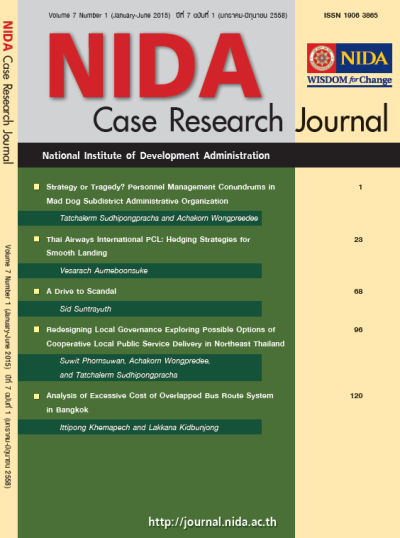Analysis of Excessive Cost of Overlapped Bus Route System in Bangkok
Keywords:
Public transportation system, Computerized system, Overlapped bus routeAbstract
Bangkok, as the capital of Thailand, has been drastically growing in economic aspect and population. It has also been ranked as one of the top destinations over the past decades. It therefore attracts more immigrants from the rural areas and tourists from several parts of the world. One of the main drawbacks in Bangkok is public transportation system. Unlike other capitals of the developed and some developing countries, public transportation in Bangkok is not fully organized. Bus transportation is the core of the current system and it is operated by the Bangkok Mass Transit Authority (BMTA). According to the BMTA annual report 2011, it operates 108 bus routes and has been suffered from an accumulated loss of over 5 billion baht (approximately 160 million dollars). Three key causes of such loss include bus routes, policy conflicts and its quality of services. Most of the bus routes managed by BMTA are long and overlapped. There are plenty of buses on the same routes, especially in the city centers. Further, long route decreases the number of operating cycles, generating less income. The BMTA provides transportation services to the public and it also aims for profits. Ticket prices have to be maintained as long as possible in order to minimize the impacts, especially to the low-income. The investment has been temporarily ceased which has crucial effects to its quality of services. The passengers usually have to wait for their buses for an unknown period of time and the buses do not provide acceptable comfort. Therefore, the “BMTA ex-passengers” gave up and arranged to own personal vehicles. The number of private vehicles is increasing and it results in an increased severity of traffic-jam problem in Bangkok. Such effects undoubtedly worsen the BMTA’s crisis.
Overlapped bus routes directly affect the BMTA’s operations as they increase the number of vehicles in the traffics and decrease the number of operating cycles. This case presents an analysis of the effects of the overlapped bus route operated by the BMTA. Current situations including operating and financial aspects of the BMTA, together with its plans are provided. A computerized system has been developed to support data input, processing and output – both reports and graphical representations. The bus route is simulated by the graph theory where a node represents main bus stop or junction and an edge represents bus route. The results demonstrate degree of the existing overlaps and their corresponding costs. Further, several feasible policies on bus route adjustments and the feasible corresponding impacts are introduced.




